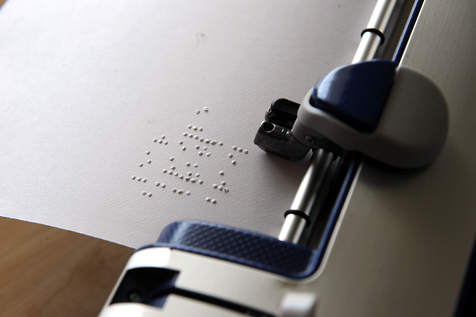Braille Nameplates: The History of Braille Printing & Engraving
What is Braille?
Braille is a system of raised dots that scholars created to help those with poor eyesight read and write through tactile signs. The braille alphabet was created throughout years of trial and error, though. It faced several adversities along the way. Now, custom braille signs are a regular staple in society, ensuring the comfort of the blind and visually impaired.

Interestingly, braille is read from left to right but is written from right to left. Although it is similar to whatever language it’s translated into, braille differs from traditional language in many ways. Unfortunately, this component was often responsible for some the adversity the system faced.
The Beginnings of Braille
One of the first innovators of reading and writing for the blind, Valentin Haüy met his first blind pupil on the street. Haüy gave François Lesueur, a blind beggar, a coin as he passed by—Lesueur stopped him in his tracks when he knew the amount of the coin simply by touching it. Haüy and Lesueur worked with wooden letters, a rudimentary but revolutionary method of teaching the blind.
Six months later Lesueur had learned so quickly that France’s most educated scholars were amazed.
Years later, a three year old Louis Braille suffered an injury at his father’s workshop, causing him to lose his eyesight. Louis’ father sent him to the Royal Institution for Blind Children. This severe, destitute school taught the children with Haüy’s wooden letter system. French army members brought the method of night writing to the school years later. This later inspired Louis to create the system of braille.
The French army used night writing to communicate secret messages and for reading in total darkness. Louis noticed that the night writing had a few flaws, though. Its overly large letters, lack of punctuation, and bulky dashes made it difficult to read. Louis tinkered with the system over the years, making it so effective that he was even able to compose music in Braille.
Braille was originally rejected by some. Its opponents believed blind people should not have the independence braille would afford them. Some leaders called for the burning of braille books and the confiscation of braille writing equipment. But, braille supporters protested and it was finally adopted as France’s official communication system for the blind.
Although the process was once controversial and tedious, signs for the blind are produced around the world. Learn more about the history of engraving, another method that has transformed over the years.

 © 2025 Yeuell Nameplate & Label, 17 Gill Street, Woburn, MA 01801 |
© 2025 Yeuell Nameplate & Label, 17 Gill Street, Woburn, MA 01801 | 

